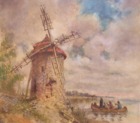|
War of 1812: Locally, the War of 1812 was concerned with the protection of borders rather than the freedom of the seas. Unlike previous conflicts, Detroit was directly involved, and following the Battle of the River Raisin, the English captured the region on August 16, 1812. The resulting British blockades and Indian raids caused Grosse Pointers many tribulations including near starvation and gave rise to a new fear of Indians. After September 29, 1813 when the United States retook the area, farmers were expected to billet American soldiers despite their previous hardships. Peace returned when the 1814 Treaty of Ghent reinstated prewar Great Lakes boundaries and the 1817 Rush-Bagon Agreement disarmed Great Lakes military fleets.
Grosse Pointe in the Early 1800s--New Neighbors, New Influences: Though fully inhabited along the lake before 1800, Grosse Pointe remained a hinterland. Occasional Catholic Masses were provided by circuit riders like Father Gabriel Richard, who arrived at Saint Anne’s in 1798. A tall, crucifix, carved about 1805--possibly by a Native American--was found above Vernier Road. It was 1825 before St. Paul Catholic Parish built a small log chapel nearby. Local schools did not appear until the 1840s even though Father Richard had earlier collaborated with Detroit's first Protestant pastor, Reverend John Monteith, to improve the city’s education. Today, Grosse Pointe has elementary schools named for both men.
The arrival of Detroit's first steamboat in 1818 and the opening of the Erie Canal in 1825 stimulated westward migration. Ships passing the 1838 Windmill Pointe Lighthouse with cargoes of immigrants and merchandise received fresh produce and fish from Grosse Pointe farm canoes. Yet French language and traditions remained prevalent in Grosse Pointe until after the Civil War, despite new arrivals. Some, with names like Vernier, Cadieux and Kerby, acquired land by marrying daughters of local families. Others bought their property. Louis Moran purchased acreage from the Alexander Grant estate while Pierre Provencal acquired part of P.C. 618 from the Forsyths. Grosse Pointe streets bear many of these names today.
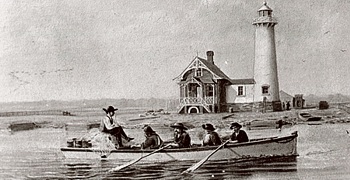
In 1832 Indian raids on the Upper Mississippi developed into the Black Hawk War. Soldiers traveling to the conflict by boat brought cholera to Detroit. To escape its effects, townspeople temporarily moved into the countryside. Pierre Provencal and his wife Euphemia would eventually raise twenty-four children orphaned by this and later epidemics. Their home, moved about 1914 from Lake Shore Road to 376 Kercheval Avenue, is possibly the oldest remaining house in Grosse Pointe and now serves as the headquarters of the Grosse Pointe Historical Society.
The Effect of Statehood: On February 26, 1837 Michigan, with its capital at Detroit, joined the Union as the 26th state. One year later, at the end of the Mexican-American War, southeastern Hamtramck Township became Grosse Pointe Township; it extended from Waterworks Park to the County Line and inland beyond Gratiot Avenue. 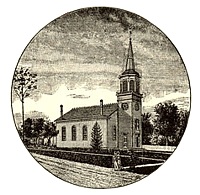 Michigan's constitution mandated that each township support district public grade schools. Along the shore, the new township's Districts #1, #2 and #3 served present-day Grosse Pointe. In 1848, the St. Paul Catholic Parish built a clapboard church at its present site on Lake Shore Road. Twenty years later, the cemetery behind this church would be moved to Moross Road. Commerce between Grosse Pointe and Detroit improved with the 1851 opening of a plank toll road along today's Jefferson Avenue. Michigan's constitution mandated that each township support district public grade schools. Along the shore, the new township's Districts #1, #2 and #3 served present-day Grosse Pointe. In 1848, the St. Paul Catholic Parish built a clapboard church at its present site on Lake Shore Road. Twenty years later, the cemetery behind this church would be moved to Moross Road. Commerce between Grosse Pointe and Detroit improved with the 1851 opening of a plank toll road along today's Jefferson Avenue.
The Civil War: In the decades before and after the Civil War, Grosse Pointe fisheries, worked by the Kerbys, Morans and Miches, supplied Detroiters with much of their whitefish and muskalonge. During the same time, a new group of immigrants, the Belgians, began developing truck farms inland along Grosse Pointe's Black Marsh. When the Civil War (1861-1865) curtailed such activities, local men either joined or were conscripted into the Union Army and traveled to campaigns far from Grosse Pointe. Like the voyageurs before them, they left behind women and children to sustain farms and family businesses, frequently for the war's duration. A journal kept by Frederick Newf documented the tedium and occasional conflict experienced by Grosse Pointers at the front.

The Summer People Arrive: As Detroit began to industrialize, its affluent citizens, hoping to escape city summers, discovered the pleasures of Grosse Pointe and began to replace farms with vacation cottages. Uprooted habitants moved elsewhere, opened small, local businesses or sought work on the new estates. About 1850 George Lothrop, lawyer and later U.S. Ambassador to Russia, was the first to move his family to Lake Shore Road. He was joined in the 1860s by the Brushes, Hinchmans and Woodbridges. In 1875, railroad car manufacturers, James McMillan and John Newberry built Lake Terrace, twin Victorian cottages on former Grant property. After the 1880s when the Halls, Muirs, Ledyards and "Detroit" Morans added increasingly elaborate summer homes, the enclave became known as "The Newport of the Midwest."
Life in the summer colony was informal. For men with jobs in the city, a cooperatively-owned steamer, Leila, kept a daily schedule to and from Detroit. Private yachts were considered indispensable for both transportation and entertainment. 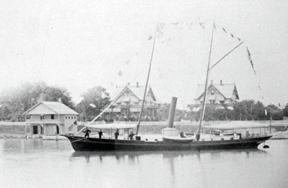 Lounging on boat decks or cottage verandas were accepted activities as were boating, swimming, tennis and biking. Everyone enjoyed parties and special activities at the Grosse Pointe Club (est. 1886). The colony's young men, always in demand, were greatly missed during summer 1898 when they briefly joined the U.S. Navy aboard the U.S.S. Yosemite to serve in the Spanish American War. Later that year, some of them helped to acquire the Grosse Pointe Club, renamed it the Country Club of Detroit and endorsed the addition of a course for the newly popular game of golf. Lounging on boat decks or cottage verandas were accepted activities as were boating, swimming, tennis and biking. Everyone enjoyed parties and special activities at the Grosse Pointe Club (est. 1886). The colony's young men, always in demand, were greatly missed during summer 1898 when they briefly joined the U.S. Navy aboard the U.S.S. Yosemite to serve in the Spanish American War. Later that year, some of them helped to acquire the Grosse Pointe Club, renamed it the Country Club of Detroit and endorsed the addition of a course for the newly popular game of golf.
Connections with Detroit were improving. In 1888 streetcars traveled from the City to Fisher Road via Mack and St. Clair. Service on the Jefferson Avenue Railway began in September 1891. When summer residents objected to its proposed Lake Shore Road route, Grosse Pointe Boulevard was developed as a compromise In 1898 the Rapid Railway System completed the Shore Line Interurban along the Jefferson route from Detroit through Grosse Pointe to Mt. Clemens.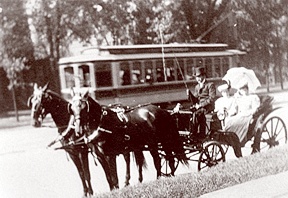
With the advent of the Interurban, average Detroiters, who had always enjoyed visits to Grosse Pointe, made the area a favorite destination for a day of fresh air, picnics and sports. Taverns, where betting was often intense, sponsored cockfights, archery contests and pigeon races. At roadhouses like Fisher's, Weaver's and Blondell's, patrons enjoyed fish, chicken or frogleg dinners.
Late 19th Century Churches and Schools: Before the Civil War, Grosse Pointe Protestants established their first congregation, the Grosse Pointe Protestant Evangelical Association, but had to wait until 1867 to build their church -- a steepled, wooden structure on donated Kerby land at Lake Shore Road. By 1881 this ecumenical group had sufficient members to hold services year-round and in 1894 moved to the "Little Ivy Covered Church" near Fisher Road. Meanwhile, St. Paul Catholic Church also found its parish expanding, and in 1899 dedicated its present sanctuary.
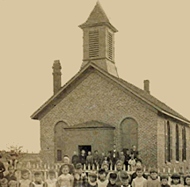 On adjacent land in 1885, the Sisters of the Sacred Heart opened the Convent, a private boarding school for "young ladies" state-wide. The next year, they started a free school for parish children and continued as their teachers until completion of the St. Paul Parochial School in 1928. To existing public schools, the Township added the Hanstein School (District #7) in 1881, the Cook School (District #9) in 1890 and the Cadieux School (District #1) in 1905. It relocated Kerby School (District #2) in 1886 and expanded Trombley School (District #1) in 1901. Of these original buildings only the Cook School on Mack and the Cadieux School on St. Clair remain. On adjacent land in 1885, the Sisters of the Sacred Heart opened the Convent, a private boarding school for "young ladies" state-wide. The next year, they started a free school for parish children and continued as their teachers until completion of the St. Paul Parochial School in 1928. To existing public schools, the Township added the Hanstein School (District #7) in 1881, the Cook School (District #9) in 1890 and the Cadieux School (District #1) in 1905. It relocated Kerby School (District #2) in 1886 and expanded Trombley School (District #1) in 1901. Of these original buildings only the Cook School on Mack and the Cadieux School on St. Clair remain.
Village Government: Grosse Pointe Township was required by law to regulate villages within its boundaries. Its first municipality, the Village of Grosse Pointe was incorporated in 1879; it reached from above Provencal Road to Fisher Road. In 1889 the boundary was extended to Cadieux Road. This community, following a foiled cottagers' attempt to create a separate, shoreline hamlet, was divided in 1893 at Fisher Road, with the eastern portion becoming the Village of Grosse Pointe Farms. In 1907, when Detroit annexed the Village of Fairview to Wayburn Avenue, the area from there to Cadieux Road was incorporated as the Village of Grosse Pointe Park. In 1911 residents along the lake established the Village of Grosse Pointe Shores, which extended into Macomb County's Lake Township. Inland, residents waited until 1927 to create the Village of Lochmoor.
|
